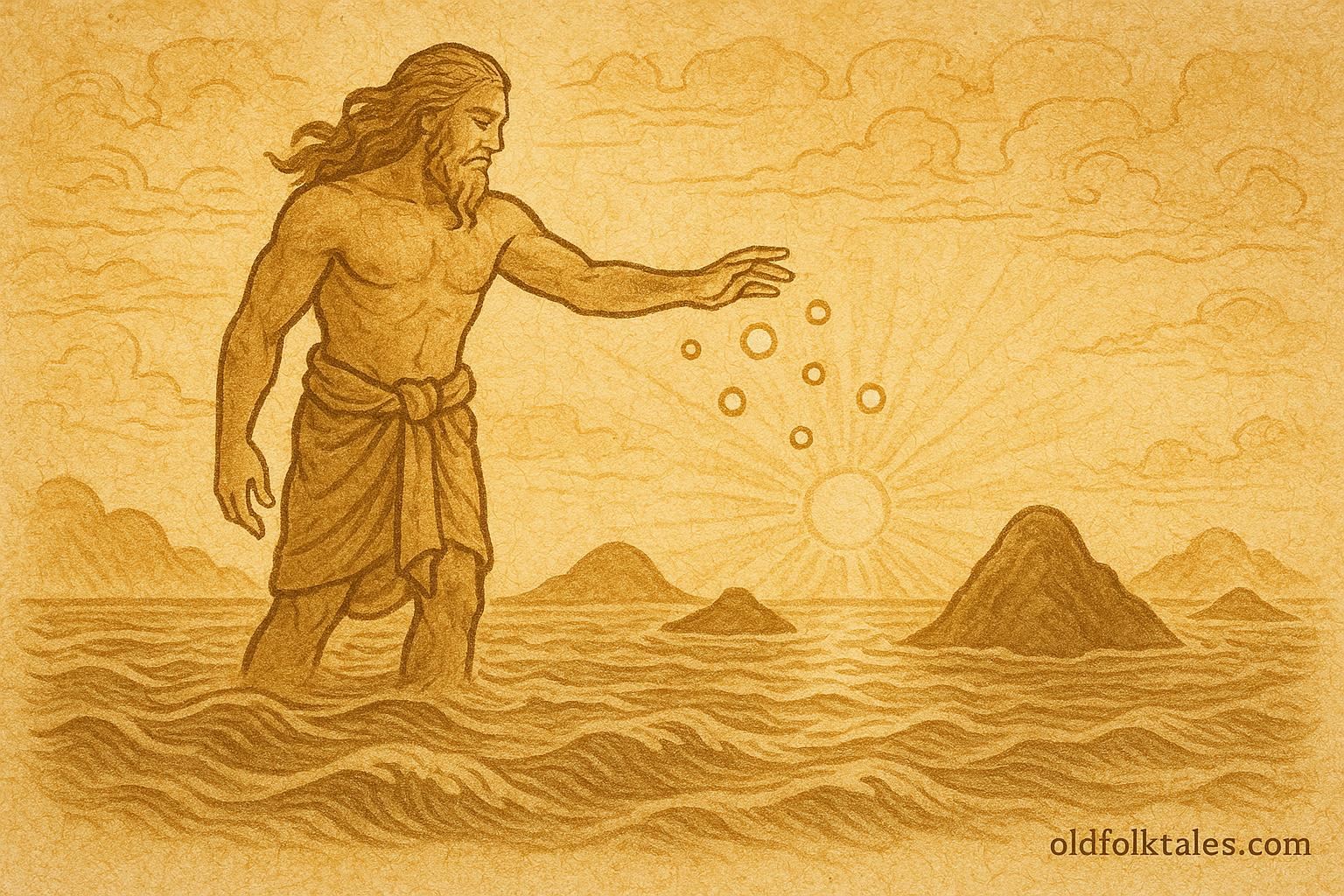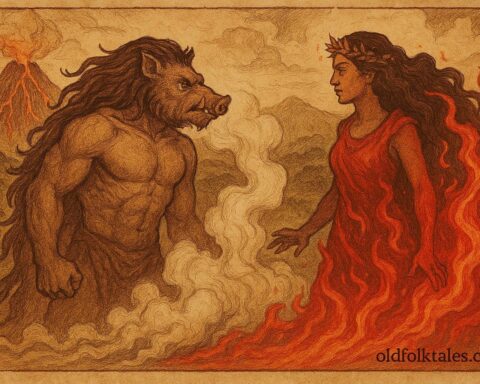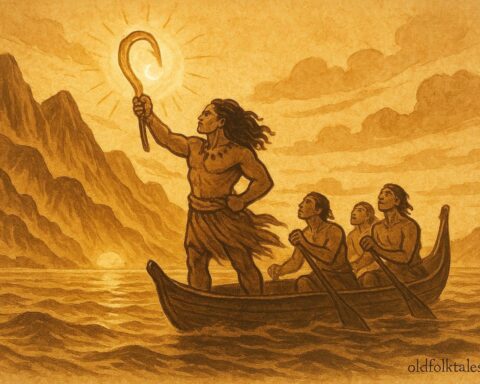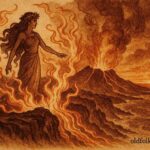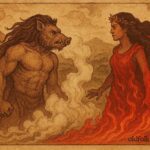In the earliest time, before there were lands or people, there was only the endless expanse of the ocean, a vast, shimmering mirror stretching to every horizon. Its waters moved gently, rippling with the rhythm of the winds that swept across its surface. There were no shores, no mountains, no birds, and no fish, only the eternal sea beneath the vault of heaven.
High above this endless water dwelled Tagaloa, the supreme god of the heavens, ruler of all that existed. From his celestial home, he gazed down upon the deep blue below. The sea glittered beautifully in the sunlight, but to Tagaloa it appeared empty, a great body without purpose. The heavens were radiant and alive with divine energy, yet the ocean waited, silent and still, longing for meaning.
Click to read all Aboriginal Australian Folktales — sacred Dreamtime stories that reveal how the world, people, and animals came to be
As Tagaloa watched, a feeling stirred within him, a longing to bring form to the formless, life to the lifeless. From this divine thought, creation began.
He gathered sacred stones from the heavens, each glowing with the power of his will. Holding them high, he looked down upon the ocean and said, “Let there be places for life to stand, places to hold the breath of my creation.” Then he cast the stones downward.
The first stone fell swiftly through the clouds, striking the surface of the sea with a hiss of steam. The waters parted and bubbled, and when they settled, a mound of dark rock rose to meet the sky. Tagaloa smiled at this new form and called it Motu, the first island.
Encouraged by his success, Tagaloa continued. Stone after stone he threw, and each sank deep into the ocean before rising as land. The sea, once boundless and lonely, became adorned with these scattered jewels of rock and soil. The islands formed a chain across the waves, the islands of Samoa, each one shaped by the divine hand of Tagaloa.
The god descended to inspect his work. Where the stones had landed, he saw mountains climbing toward the clouds, valleys rich with rain, and streams cutting paths through the new earth. He painted the lands with green, summoning trees and grasses to sprout from the soil, birds to sing among the branches, and fish to fill the surrounding waters. Soon, the world echoed with the sounds of life, and the ocean that once whispered in solitude now hummed with harmony.
Yet even as beauty flourished, Tagaloa felt something was missing. The trees bent with fruit, and the waves sparkled under the sun, but there were no beings to see, to feel, or to praise the work of creation. The land was alive, but it was silent.
Tagaloa looked upon the red clay and the golden sands of Samoa and said, “From this earth, I shall shape companions who will know the value of life.” Kneeling beside a stream, he gathered the soft soil in his hands. He molded figures with care, forming arms to work, eyes to see, and hearts capable of love and reverence. When he was satisfied with their form, he bent close and breathed life into them, the breath of the heavens entering the clay of the earth.
The figures opened their eyes and rose, their skin warmed by the sun, their hearts beating in rhythm with the ocean. They looked upon the mountains and the trees, the sky and the sea, and marveled at the beauty around them. Instinctively, they bowed before Tagaloa, knowing he was their creator, their source, and their protector.
Pleased with their gratitude, Tagaloa spoke to them, saying, “These islands are my gift to you. Guard them well, for they are sacred. The sea will feed you, the land will shelter you, and the heavens will watch over you. Honor the balance of all things, and life will flourish.”
The people, filled with awe, vowed to live in harmony with nature and the divine. They built their homes along the shores, fished the lagoons, and planted gardens in the fertile soil. They raised temples of coral and stone in Tagaloa’s name, where chants and songs would rise toward the heavens like waves of praise.
Generations passed, and the islands became vibrant with human life. Children played along the beaches, elders told stories under the stars, and every dawn was greeted as a blessing from above. When storms came, the people believed it was Tagaloa’s reminder to remain humble before the might of creation. When the rains ended and rainbows arched across the sky, they saw them as signs of his favor.
Even now, Samoan elders say that when the sea glows gold at sunset or the wind moves softly through the palms, Tagaloa walks among his islands once more. The waves that kiss the shores are his eternal breath, the same divine breath that gave life to humanity and shaped the world from the silent sea.
And so, the people of Samoa remember that their islands are not merely land but sacred gifts, reminders of the divine harmony that connects heaven, earth, and sea. Every rock, every coral reef, and every tide carries within it the memory of Tagaloa’s touch, the breath of the creator who shaped the ocean into home.
Moral Lesson
The tale of Tagaloa reminds us that the world is sacred and creation is a gift of balance. We are caretakers of the land and sea, bound by gratitude to protect the harmony that sustains life. To honor creation is to honor the divine within it.
Knowledge Check
1. Who is Tagaloa in Samoan mythology?
Tagaloa is the supreme creator god of Samoa, who formed the islands and the first humans from the heavens above.
2. What did Tagaloa throw into the ocean, and what did they become?
He cast down stones from the heavens, which became the islands of Samoa.
3. How did Tagaloa create the first humans?
He shaped them from the earth and breathed divine life into them, giving them body and spirit.
4. What does the ocean symbolize in this folktale?
The ocean represents both the beginning of all things and the balance between the heavens and the earth.
5. What moral lesson does the story convey?
It teaches respect for creation and gratitude toward the divine forces that shape life and nature.
6. Why are the islands of Samoa considered sacred?
Because they are believed to be direct gifts from Tagaloa, formed by his hands and blessed by his breath.
Source: Adapted from Myths and Legends of Samoa by E.W. Gibb (1907).
Cultural Origin: Samoa (Polynesia).
